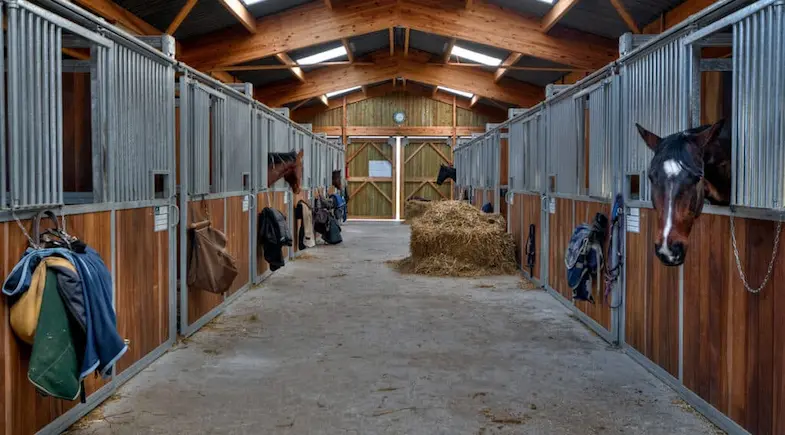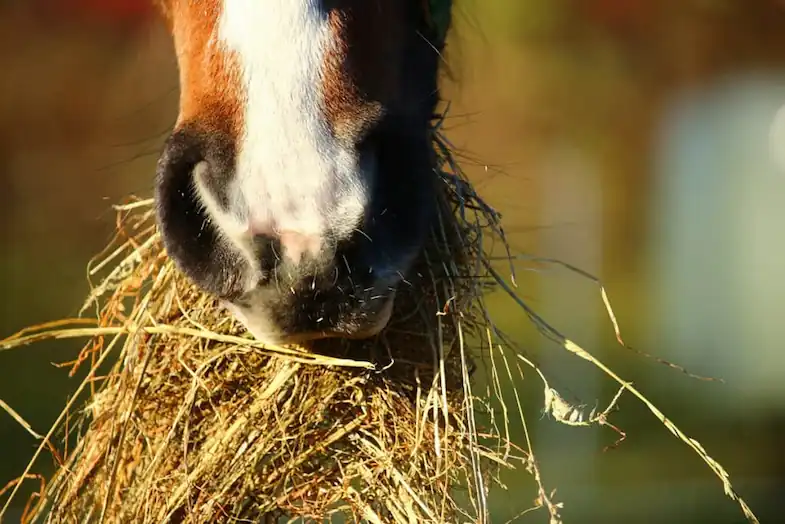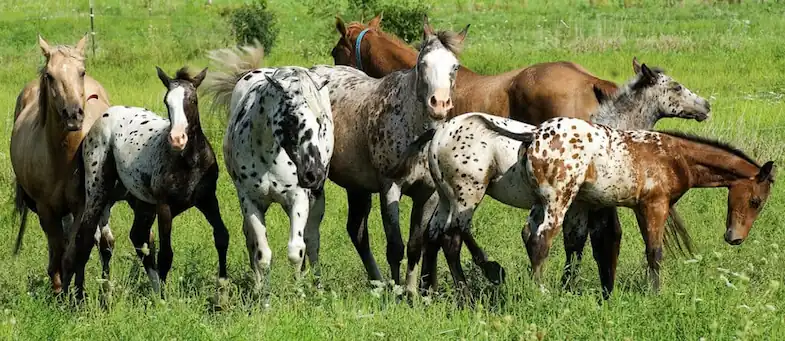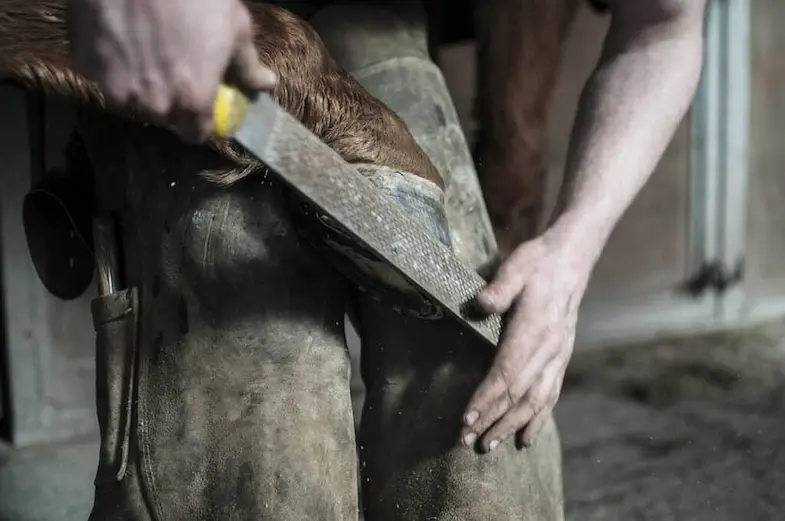Owning a horse is a wonderful thing but, as with any animal, it also involves a huge amount of responsibility, after all the health and wellbeing (as well as the mental wellbeing) of your horse is completely in your hands. That said, owning a horse is also extremely rewarding as the two of you build and strengthen your bond and friendship.
If you’ve never owned (or leased) a horse before then it can be difficult to know just how much work is involved but armed with a little bit of knowledge and preparation you’ll be ready for anything.
How do you tie a horse up?
At first, it might not seem like an important thing to know but being able to tie your horse up securely is far more crucial than you might think, and to some extent the first thing you should learn. If you’re not able to tie your horse up then you won’t be able to groom him, check him for any injuries, clean his hooves, or even to muck out his stall properly.
There are a number of different knots you can use but the best (and most common) is known as a quick release knot, its good because you can secure your horse safely but at the same time, with a quick pull on the lead line you can also free him if you need to urgently.
How to tie a quick release knot
- Start by feeding the lead line through (or round) whatever you’re securing your horse too.
- Bring the loose end in front of the rope and then behind both strands.
- Make a fold in the loose end and feed it through the loop created in the previous step.
- To tighten the knot pull on the end that’s attached to your horse (make sure you don’t pull your horse’s head though).
Is it hard to take care of a horse?
It’s not difficult to care for a horse but it does help if you break everything down into different tasks, for example, caring for a horse sounds like a massive task but feeding, grooming, mucking out, etc make it much more manageable.
Where should you keep your horse?
Unless you’re one of those lucky people who keep their horse at home you’ll need to find a boarding stable or livery yard for your horse. There’s a range of options and which one you choose will be dependent on a number of factors such as your horse’s needs as well as your finances.
- Self-board (also known as DIY) – If you want to stable your horse then this is the cheapest form of livery but also requires the most amount of work from you. You’ll be in charge of feeding your horse, mucking out his stall as well as turning him out and bringing him back in each day.
- Pasture board (or grass livery) – If you decide to not stable your horse at all then pasture board will be the best solution for you. Your horse will be turned out all year round and like self-board you’ll be in full charge of your horse’s daily care (although you obviously won’t need to muck a stall out).
- Assisted – Not all yards will offer this, but it’s essentially self-board with help, often the help is in the form of feeding, mucking out, turning out, etc. The cost will be determined by how much assistance you need but it’s perfect if you want to keep the cost down but aren’t able to visit your horse a couple of times a day.
- Partial board (or part livery) – This is by far the most popular option and is ideal for owners who don’t have the time to care for their horse on a day to day basis. Your horse will typically be fed, mucked out, and turned out (as well as brought back in again).
- Full board – If you have the money but not the time to own a horse then full board is for you, you get all of the benefits of partial board but on top of that your horse is also groomed and exercised. This means that you don’t need to worry about exercising your horse if you don’t have time. You can, of course, ride whenever you do have time but may need to let the yard know so your horse isn’t overworked.
- Working livery – Available at many riding stables, your horse is kept on partial board but the cost of this is reduced in return for your horse being used for riding lessons. While this can keep the costs down it does mean that you’re not always able to ride your horse.
If, however, you are able to keep your horse at home then you might find this recent article helpful.

Feeding your horse
Regardless of whether you’re stabling your horse or keeping him at pasture, he’ll still need to be fed, in fact, a horse should eat around 2.5% of their body weight each day but this is made up of concentrate (which is the horse’s feed) and forage (such as hay, grass, alfalfa, etc). The ratio of concentrate to forage will depend on how easily your horse puts weight on as well as what his workload is, but as a guide, the average horse (if there is such a thing), needs 20% concentrate and 80% forage a day. The table below will help you to get an idea of what your horse needs.
| Horse’s weight in Kg (approximate hands) | Concentrate (Kg) | Roughage (Kg) | Total (Kg) |
| 200 (8) | 1 | 4 | 5 |
| 300 (11) | 1.5 | 6 | 7.5 |
| 400 (14) | 2 | 8 | 10 |
| 500 (15) | 2.5 | 10 | 12.5 |
| 600 (16) | 3 | 12 | 15 |
| 700 (17) | 3.5 | 14 | 17.5 |
| 800 (18) | 4 | 16 | 20 |
Just like us, horses also need certain vitamins and minerals so if your horse isn’t able to get this from his diet or grazing then you will want to think about topping his feed up with supplements. The main vitamins and minerals a horse needs are:
Vitamins
- Vitamin A
- Vitamin C
- Vitamin D
- Vitamin E
- Vitamin K
- Thiamine (B1)
- Riboflavin (B2)
- Niacin (B3)
- Pantothenic Acid (B5)
- Pyridoxine (B6)
- Biotin (B7)
- Folic Acid / Folate (B9)
- Cobalamin (B12)
Minerals
- Calcium
- Magnesium
- Phosphorus
- Potassium
- Sodium
- Chloride
- Sulfur
- Cobalt
- Copper
- Fluorine
- Iodine
- Iron
As well as feed, your horse also will need fresh drinking water every day, the average horse will drink 5 to 10 gallons of water (depending on the temperature) a day so unless you have an automatic water trough you’ll need to keep this topped up.

Your horse’s health
Sadly horse’s can’t talk to us (at least in a way we can fully understand) so it’s important to know your horse as well as what’s normal for him. This will help you to recognize when something is wrong. This article tells you how to check your horse’s vital signs as well as what to look out for but as a rough guide an average adult horse’s vital signs should be:
- Temperature (°F / °C) – 99.5-101.5 / 37.5-38.6
- Pulse (bpm) – 24-40 (32 to 36 is the average)
- Respiration (bpm) – 8-12
- Mucous membrane – Pink and moist
- Capillary refill – Less than three seconds.
You also need to have your own horse first aid kit so that you can treat any injuries immediately, you can buy ready-made kits or you can easily make your own. You should also write your number as well as your vet and farriers numbers on the top of the kit and leave instructions for any prescribed medication inside.
Grooming your horse
Grooming is more important than you think and isn’t just for keeping your horse clean, you’ll also be able to check him for cuts, scratches, and other injuries. Within a herd, horses groom each other not only to bond but also as a way of establishing their position within the herd itself. Your horse will benefit tremendously from being groomed but many owners enjoy the one to one time they spend with their horses while grooming.
When it comes to the grooming kit itself there’s not a huge amount that you actually need to get started and believe me you’ll soon accumulate items as you go! A basic grooming kit should contain the following:
- Hoof pick – Probably the most important item because it’ll allow you to remove stones and debris from your horse’s hooves. I’d even go so far as to say you should have a few in different places, and a foldable one for when you’re out riding.
- Rubber (or plastic) curry comb – It doesn’t matter whether you use a rubber or plastic curry comb, they’re both perfect for removing loose hairs and caked in mud. You can also use a circular metal curry comb but personally I’m not keen on using them on my horses. Whichever curry comb you use you shouldn’t use it on your horse’s face or other sensitive areas.
- Flat metal curry comb – While you can remove the mud and hair from your brushes by hand I find it much quicker to use a metal curry comb.
- Dandy brush – The bristles on a dandy brush make it ideal for remove ground-in dirt but because the bristles are relatively tough you shouldn’t muse this on your horse’s face or legs.
- Body brush – This is a much softer brush that can be used everywhere on your horse, although you still need to be gentle around his face.
- Sponges – These are so useful for cleaning sensitive areas such as around your horse’s eyes, nostrils, and anus, ideally you need at least three different sponges so you can keep them all separate, after all, you wouldn’t want to reuse toilet paper would you! Sponges are one of those things that you’ll find yourself regularly buying, they’re always useful.
- Hoof oil (and brush) – You might think that hoof oil is only for show but it can help to protect your horse’s hooves from drying out and cracking so should be used regularly.
If you want to read more about how to groom a horse you might find this article on pro grooming tips helpful.
How to keep your horse happy
Now that you’ve taken care of your horse’s shelter, feed, and his health as well as grooming him its time to start to think about keeping him happy. Horses are herd animals and can become very stressed (and even depressed) when they’re separated from other horses for a prolonged period of time. If you do have to do this then you might want to think about different toys or ‘distraction’ methods that will help to relax and de-stress him.
As well as toys you can use lavender (it doesn’t matter if its dried, oil, or just a spray) to help keep your horse calm, it works just as well with horses as it does with us. It might sound like a silly thing to suggest but a horse safe mirror in your horse’s stall will also stop him from feeling isolated and cut off from other horses. It works because your horse will think because it looks like, acts like and smells like (the whole yard will smell of horses) a horse it must be. The only caveat I’ll add though is, if your horse is protective of his food, don’t put it too close to his buckets otherwise he could end up fighting with himself for the food, yes horses really can be that daft.
If you only have one horse and aren’t able to keep it with other horses then you might want to consider other animals for company instead, sheep, goats, and even chickens can make great alternative companions for your horse. I recently wrote an article on preventing loneliness in horses that also gives a number of other solutions.

How much care does a horse need?
You don’t need to spend all day caring for your horse but you (or somebody else) will need to dedicate at least an hour or two every day in order to make sure he’s safe, healthy, and happy.
Some tasks will need to be done every day while others will only need to be done weekly, monthly (or even bi-monthly), or annually. I find it easier to use a wall planner to organize my time but that may not work for you. As a guide though I’ve tried to list what needs to be done when.
Daily horse care
- Water – You’ll need to give your horse fresh water a couple of times a day, especially if the weather is hot. When the weather’s very cold though you might want to think about having the water heated. If you have an automatic water trough you won’t need to fill that but you’ll still need to make sure it’s working properly and there are no blockages.
- Food – Horses have small stomachs and slow digestive systems so need to eat little and often, depending on how much your horse eats he may need two or three meals (of concentrate) a day.
- Grazing – On top of his concentrate feed your horse will also need a lot of forage, whether it’s from grazing, hay or other roughage you need to make sure he has enough.
- Rugs – If your horse is wearing a blanket (or summer/fly sheet) then you’ll need to give it a quick once over to make sure it’s not damaged and it securely fastened and won’t come loose. Depending on the weather and whether or not your horse is stabled you will also need to change his rug.
- Shelter – You don’t need to spend long making sure the shelter is okay, just a quick once over to make sure it’s not damaged and there are no loose splinters that could hurt your horse.
- Muck out – Urine and manure both produce ammonia as they break down which can harm your horse’s lungs and damage his hooves so it’s important to clean this out daily. Some people choose to muck out thoroughly every day while others will skip out (where you just clean up the dirty bedding and top up where needed) every day.
- Clean hooves – You need to check your horse’s hooves every day for signs of damage as well as infection. It’s also important to pick out any stones, debris, or compacted bedding.
- Groom – You don’t want to give your horse a thorough, show quality groom every day because it’ll remove the oils he needs to help regulate his body temperature as well as to keep dry but you should brush the mud off of him regularly.
- Check for injuries – While you’re giving your horse a quick groom you should also check him over for any injuries and treat them accordingly.
Weekly horse care
- Muck out – If you choose to skip out your horse’s stall instead then you’ll need to muck it out completely once a week. You can then get rid of all of the bedding and replace it with clean fresh bedding.
- Check food and bedding levels – You should have around two weeks’ supply of feed and bedding and checking the levels every week will help you to make sure you don’t run out.
- Clear pasture – Getting rid of manure will not only help to reduce the number of flies but it will also help to keep your horse free of worms (or at the very least reduce the number of times he needs to be wormed).
- Check fencing – Make sure there’s no broken rails or loose nails (both of which should be either repaired or removed straightaway) that could either injury your horse or allow him to escape.
- Scrub buckets and troughs – Thoroughly cleaning the feed and water buckets and troughs regularly will help to prevent the build-up of food which can spoil. Water troughs can also get clogged with hay and algae as well as with dirt.
Monthly horse care
- Remove poison plants – Horses are generally sensible when it comes to knowing what not to eat but it’s good practice to regularly clear and poisonous plants from fields.
- Farrier – Every 6 to 9 weeks (depending on the condition of your horse’s hooves as well as his workload) you have have your horse’s feet check by a farrier. They’ll be able to trim them as well as reset the shoes if your horse is shod.
- Worming – Again this only needs to be done every 6 to 9 weeks but it’s important to have a regular deworming plan.

Yearly horse care
- Check teeth – While you should be checking your horse’s teeth regularly yourself you should also have then professionally checked (either by your veterinarian or a specialist equine dentist) at least once a year.
- Vaccinations – While every vaccination will have a different schedule many will be annually so it’s important to keep on top of these.
Basic care quick guide
- Check your horse’s at least twice a day
- Make sure there is a constant supply of fresh water
- Ensure your horse has enough food for his workload
- Remove dangerous and poisonous plants from pasture
- Check all fencing regularly to make sure it’s secure
- Regularly clean all buckets and troughs thoroughly
- Make sure the stall is clean and that it’s safe
- Keep vaccinations and deworming up to date
Further reading
- Do horses need shoes?
- How to deal with mosquitoes
- How to bond with your horse
- Is leasing better than owning?
- Are horses smart?
- Life hacks for horse owners
- Household items that are barn essentials
- Camping with your horse
- How to successfully load your horse
- Preparing your horse for the winter
I hope you found this article helpful. If you did I’d be grateful if you could share it please as it would really help me.
Recommended products
Over the years I have tried hundreds of different horsey products, from various blankets and halters to different treats. Some I’ve loved, others I’ve hated but I thought I’d share with you my top all-time favorite products, the ones I never leave the yard without. I’ve included links to the products (which are in no particular order) that I really think are great.
- Horse Knots by Reference Ready – If you’re like me and enjoy pocket reference guides then you’ll love this knot tying guide. These handy cards can easily fit in your pocket or attach to the saddle for quick reference. They’re waterproof, durable and are color coded to make them easy to follow.
- Mane ’n Tail Detangler – Even if you never show your horse you’ll need to detangle his tail from time to time (and possibly his mane too) which is always a challenging chore! I’ve found that if I run a little bit of detangler through my horse’s tails every few days it stops them from getting matted up and makes combing them easy, even if they’re coated in mud. I don’t know if I should admit to this or not but it also works wonders on my hair.
- TAKEKIT Pro clippers – Over the years I’ve tried a lot of different clippers and while some were obviously better than others I found these to be by far the best. They are heavier than a lot of other clippers but for me, that’s a good thing, it makes them feel more sturdy and hardwearing. On top of that they have a range of speeds so are just as good for clipping your horse’s back as they are his face. I also like the fact that they come in a handy carry case but that’s not for everybody. The company that makes them is super good and incredibly helpful too, a real bonus these days. The only thing I wasn’t keen on was the fact that it doesn’t come with any oil, but that’s not a major problem as it’s not difficult to buy lubricant.
- Shire’s ball feeder – There are so many boredom buster toys out there but I like to use these every day, regardless of whether or not my horses are bored. I find that it helps to encourage my horses to problem solve by rewarding them with treats (or pieces of fruit) but it also mimics their natural grazing behavior which helps to keep them calm and de-stressed.
- Horse safe mirror – This is a strange one that many people are surprised about but I like to put horse safe mirrors in the trailers as well as in the quarantine stalls. It helps to prevent the feeling of isolation by giving the impression of other horses being around. Being herd animals horses can get extremely stressed when they feel that they’re on their own but with these stick-on mirrors, they believe that at least one other horse is with them.
- Rectal thermometer – I know this isn’t glamourous at all but it’s vital for your horse’s well-being to be able to check their temperature and a rectal thermometer is the easiest way of doing this which is why I’ve added it to the list.
Shopping lists
I’ve also put together a few shopping lists of essential items that I’ve found helpful over the years. I’ve broken the lists down into different categories rather than put everything in one massive list 😉

